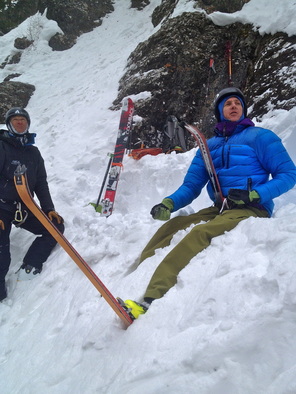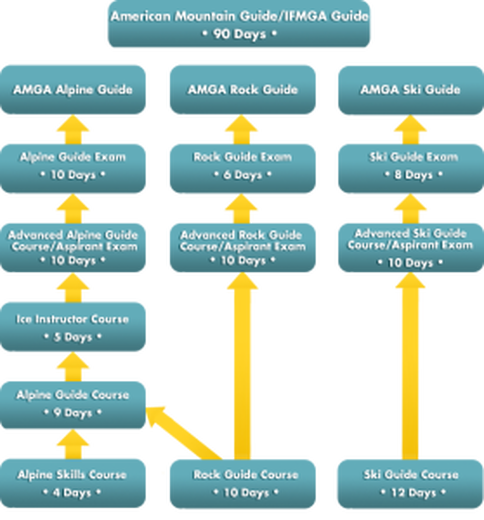Continued Education
 AMGA instructor Vince Anderson demonstrating how to add security to the guide while short roping.
AMGA instructor Vince Anderson demonstrating how to add security to the guide while short roping.
The Mountain Guide is not considered a profession here in the states as it is highly respected in Europe. It is my goal to become a certified American Mountain Guide through the American Mountain Guides Association (AMGA) by 2022. Alpine, Ski Mountaineering, and Rock guiding are the disciplines that make up the American Mountain Guide certification. One can become a guide in each one of the disciplines and when all three are accomplished, then they receive their "pin" that proves they have completed all areas of study. I like to think of each discipline being a Masters program for that type of guiding. When one pursues getting all three, they are committing to at least 4, usually 6 or more years of courses, exams, building their personal resumes, practicing various transitions until they are smooth and fast, timed rescue scenarios, avalanche education, wilderness medical training, and guiding (under examination) in new terrain under some of the most extreme conditions and/or weather. It is truly an outstanding accomplishment when one passed their last exam and stands up in front of all their instructors, mentors, and colleagues to receive their "pin."
As a AMGA Mountain Guide, one can guide in any type of terrain encountered in the mountains at the highest level of skill. It also opens up guiding in more than 20 countries recognized by the International Federation of Mountain Guide Association (IFMGA), giving my clients more terrain to challenge themselves. In 2017, the AMGA Terrain and Supervision Guidelines will take effect to keep aspiring guides in their scope of practice. In order to meet these requirements, I will need to pass my second tier of aspirant exams to guide in my current terrain. The AMGA is trying to make the profession of a Mountain Guide, a respected and valued business, where there is a set standard for all guides in the United States to follow.
As a AMGA Mountain Guide, one can guide in any type of terrain encountered in the mountains at the highest level of skill. It also opens up guiding in more than 20 countries recognized by the International Federation of Mountain Guide Association (IFMGA), giving my clients more terrain to challenge themselves. In 2017, the AMGA Terrain and Supervision Guidelines will take effect to keep aspiring guides in their scope of practice. In order to meet these requirements, I will need to pass my second tier of aspirant exams to guide in my current terrain. The AMGA is trying to make the profession of a Mountain Guide, a respected and valued business, where there is a set standard for all guides in the United States to follow.
The level of experience and expertise of being a Mountain Guide has often been compared to the practice of being a doctor. Both professions take many years to become certified and many field hours. There is a high degree of uncertainty with procedures, whether or not to perform a surgery and whether or not to ski or travel on a avalanche slope. Both have to manage a large amount of risk and uncertainty, whether it is making a delicate surgical cut that will change the life of that person forever or choosing your way through a crevasse infested field with overhanging serac fall. In order to give clients an experience that includes high levels of risk, but be able to lower the chance of that risk through careful management, a higher level of education and mentorship is necessary.
I am committed to expanding my experience and education of guiding to improve my client's experience and better manage the risk involved within objectives. Although there are scholarships within the AMGA for making courses and exams more manageable for an aspiring guide, the guiding pool is becoming larger and these scholarships are getting more difficult to receive. Unfortunately, a Mountain Guide is not a recognized profession nor is it possible to acquire student loans for AMGA education. If you have enjoyed your experience in the mountains with me, please consider helping me progress in becoming a better mountain guide by donating below.
I am committed to expanding my experience and education of guiding to improve my client's experience and better manage the risk involved within objectives. Although there are scholarships within the AMGA for making courses and exams more manageable for an aspiring guide, the guiding pool is becoming larger and these scholarships are getting more difficult to receive. Unfortunately, a Mountain Guide is not a recognized profession nor is it possible to acquire student loans for AMGA education. If you have enjoyed your experience in the mountains with me, please consider helping me progress in becoming a better mountain guide by donating below.

